The past year has seen tremendous growth across the crypto industry as a whole as layer 1 blockchains have found real-world use cases across DeFi, NFTs, gaming, the metaverse, and many other applications.
In this guide, we'll discuss two of the most widely used layer 1 smart contract platforms: Solana vs Ethereum.
We'll look at the key value propositions of each blockchain, use cases, and pros/cons of Solana vs. Ethereum. Specifically, we'll look at key factors including:
- Solana vs Ethereum Tradeoffs: the Blockchain Trilemma
- Solana vs. Ethereum: Key Stats
- Solana vs Ethereum: Overview of Each Blockchain
- Tokenomics: Solana vs Ethereum
- Staking: Solana vs Ethereum
- Scalability: Solana vs. Ethereum
- Developers on Solana vs Ethereum
Stay up to date with AI
Solana vs Ethereum Tradeoffs: The Blockchain Trilemma
Before getting into the specifics of Solana vs Ethereum, let's first review the blockchain trilemma, which as Gemini describes:
...refers to a widely held belief that decentralized networks can only provide two of three benefits at any given time with respect to decentralization, security, and scalability.
Both Solana and Ethereum do have tradeoffs between these three core components of a successful L1 blockchain. In terms of the tradeoffs between Solana vs Ethereum, the trilemma can be summarized as follows:
- Solana is highly scalable and secure, but not as decentralized as Ethereum
- Ethereum is decentralized and secure, but not as scalable in terms of transactions per second (TPS) (at least in its current form)
It's important to note that Ethereum 2.0 aims to be the perfect combination of the three. Layer 2 solutions like Polygon also help improve the scalability issue for Ethereum.
Solana vs Ethereum: Key Stats
Now that we know a few of the tradeoffs between Ethereum vs Solana, let's look at a few key stats comparing Solana vs Ethereum, including the number of projects, transactions per second, number of nodes, and total value locked.
Ethereum key stats
- Number of dapps currently on Ethereum: 3000+ (source)
- Ethereum Transactions per second: ~30 (source)
- Ethereum clients: 6400+ (source)
- Ethereum 2.0 validators: 300,000+ (source)
- Total Value Locked (TVL): $109B (source)
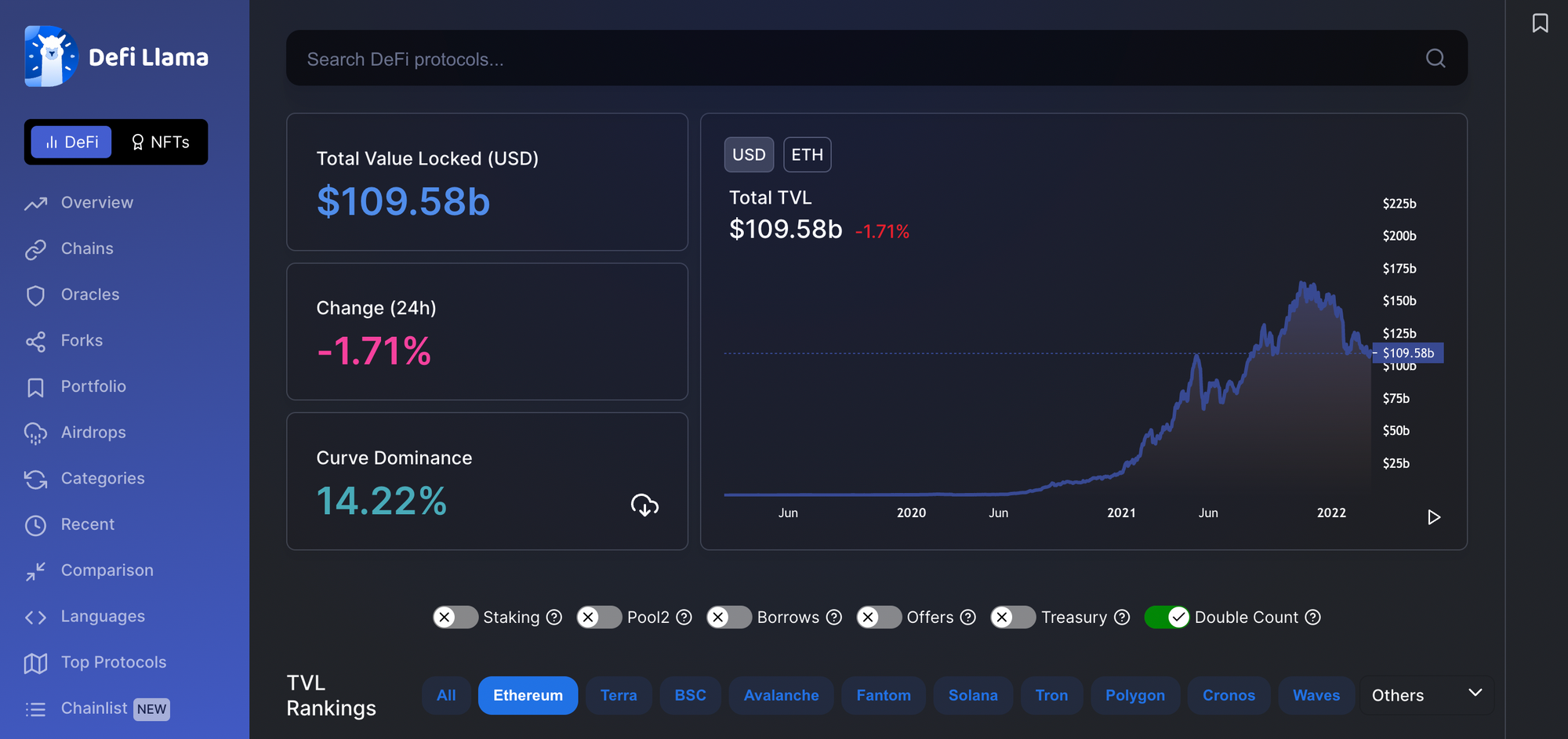
Solana key stats
- Number of dapps on Solana: 400+
- Transactions per second on Solana: 65K TPS
- Solana nodes: 1500+ (source)
- Total Value Locked (TVL): $6.94B (source)
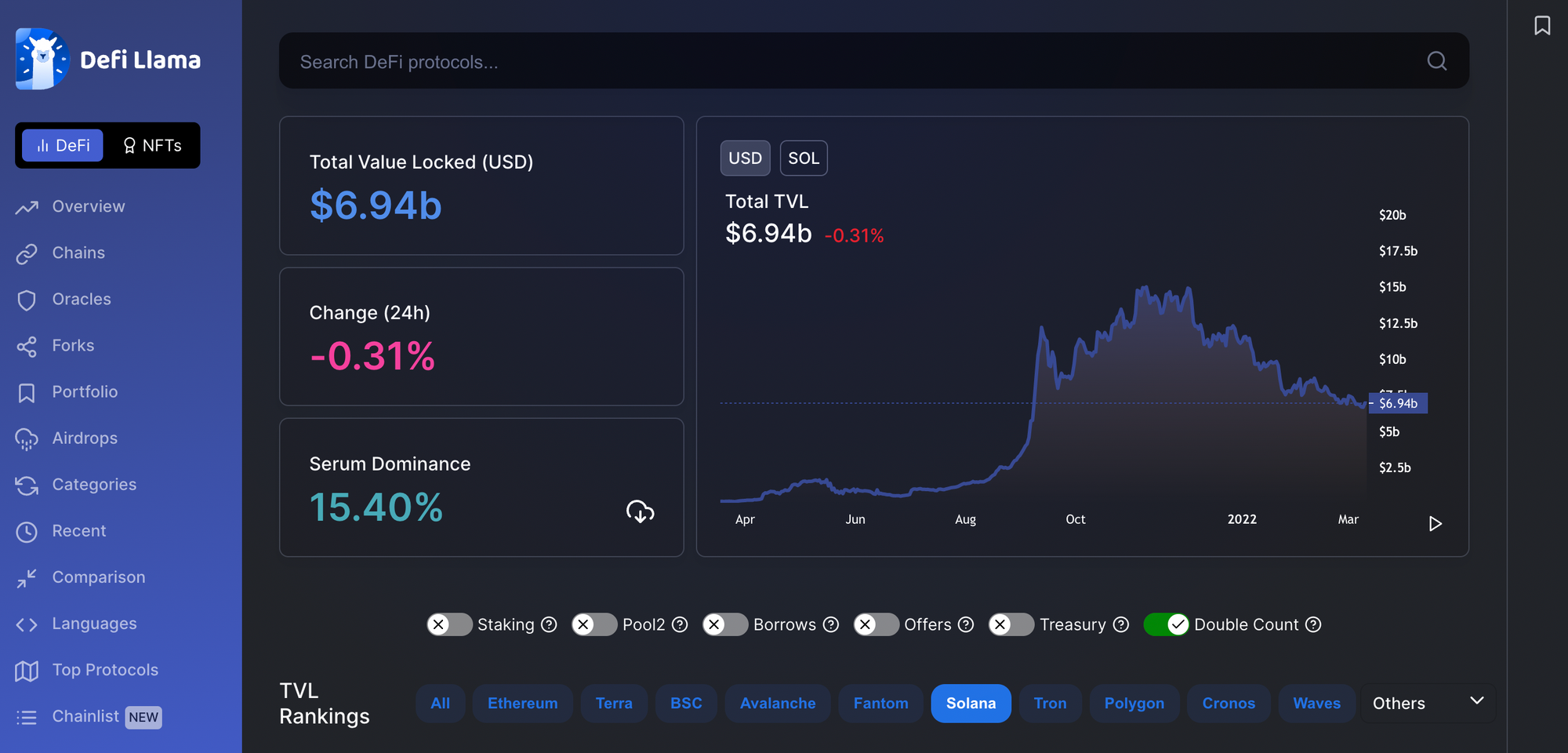
Solana vs Ethereum: Overview of Each Blockchain
Let's now review a brief overview of Solana vs Ethereum.
Ethereum Overview
Founded by Vitalik Buterin in 2015, Ethereum is currently in the process of transitioning its consensus mechanism from Proof-of-Work (PoW) to Proof-of-Stake (PoS), with completion of the transition expected to take place in Q2 2022 in a long-anticipated event termed “The Merge”.
As Ethereum.org highlights:
This eliminates the need for energy-intensive mining, and instead secures the network using staked ether. A truly exciting step in realizing the Ethereum vision – more scalability, security, and sustainability.
Ethereum can only handle roughly 30 TPS is its current state, although Vitalik has stated that Ethereum 2.0 may eventually be able to scale to 100k TPS using sharding and other scalability tactics.
There are currently ~6400+ nodes that power the Ethereum network in the top 10 countries as per Ethernode:
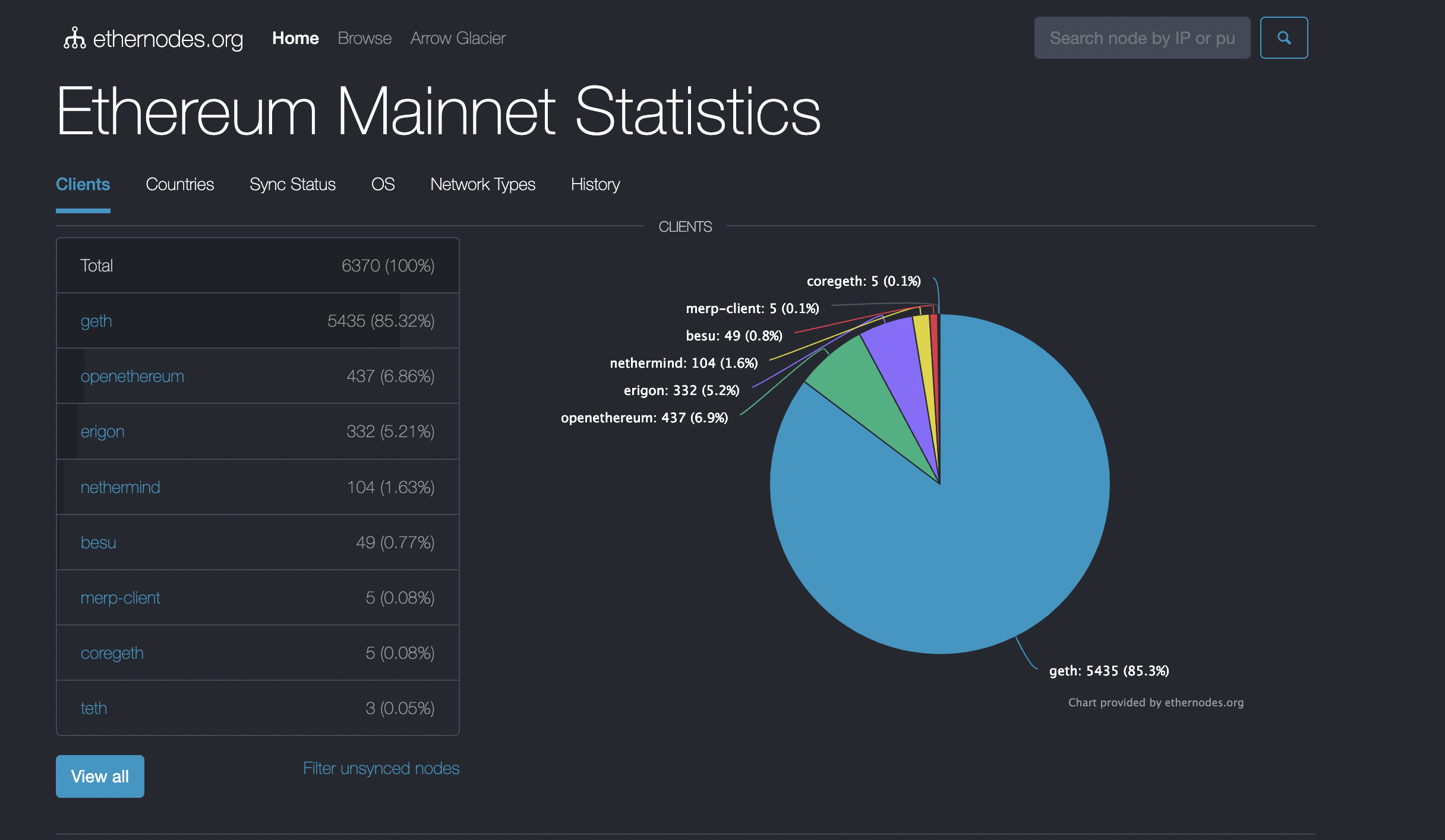
Solana Overview
Founded by Anatoly Yakovenko, Solana's mainnet beta went live in February 2020.
Solana is a Proof of Stake (PoS) blockchain, although it also uses a Proof of History (PoH) timing mechanism, which Investopedia describes as:
PoH is a proof for verifying order and passage of time between events, and it is used to encode trustless passage of time into a ledger.
As Gemini highlights, the combination of PoS and PoH result in:
...an ultrafast blockchain capable of processing more than 50,000 transactions per second, with the ability to scale as usage of the protocol grows without relying on Layer-2 systems or sharding.
Solana is also working to increase their TPS with the aim of getting to 1 million+ TPS as hardware capabilities increase. Due to it's significantly higher speed and scalability, a digital asset analyst recently stated:
Solana could become the Visa of the digital asset ecosystem
Solana currently has ~1400+ nodes on the network. The fact that Ethereum has roughly 5x the number of nodes is one of the reasons that it's slower, although as mentioned in the blockchain trilemma, this increased decentralization is also seen as a net positive by many.
Tokenomics: Solana vs Ethereum
Let's now look at the tokenomics of Solana vs Ethereum, which is the study of each cryptocurrencies supply and demand schedule.
Ethereum Tokenomics
When it comes to tokenomics, Ethereum has an unlimited supply, whereas Solana has a fixed supply of~500M tokens.
This comparison, however, is a bit misleading as Ethereum's current inflation rate is roughly 4%.
As Ethereum completes its merge to Eth 2.0 and more and more ETH gets burned its inflation rate is expected to become relatively flat, if not deflationary. As LuckyHash highlights:
At present, the average daily output of Ethereum is about 13,000, and a total of 119 million have been produced. Its annual inflation rate is about 4.1%. However, with the help of Ethereum’s burning mechanism, its inflation rate is reduced to about 1.4%, lower than that of Bitcoin (1.7%).
Solana Tokenomics
Solana's current token supply inflation rate is around ~7%. Over time, Solana's inflation rate is expected to come down to ~1%. At the time of writing, there are currently 319,345,015 SOL in circulation with a total liquid supply of 518,260,485 SOL.
In theory, Solana also has an unlimited supply of tokens as it automatically issues a new set of tokens each year based on a fixed year-over-year inflation rate.
In terms of ownership, one of the main criticisms of Solana has received since its launch is that the initial allocation of tokens favoured insiders and venture capitalists too heavily. The founders have responded to this critisism, as AMB Crypto highlights, Solana co-founder Raj Gokal replied on Twitter:
if there were a way to get a layer 1 built from scratch with less VC funding, less allocation for insiders, and more allocation for the public, we would have done it.
— raj.sol 🇺🇦 (@rajgokal) December 16, 2021
the market was very different back then, and we barely scraped by.
Anatoly Yakovenko also responded to the criticism:
Foundation is distributing tokens to those who put in the work of maximizing censorship resistance over long period of time and demonstrate the operational skills of running an honest replica that can participate in recovery from catastrophic failures. Wtf else should it do?
— Composability T◎ly, 🖤 (@aeyakovenko) December 16, 2021
Here's an overview of the Launch & Initial Token Distribution from Messari:
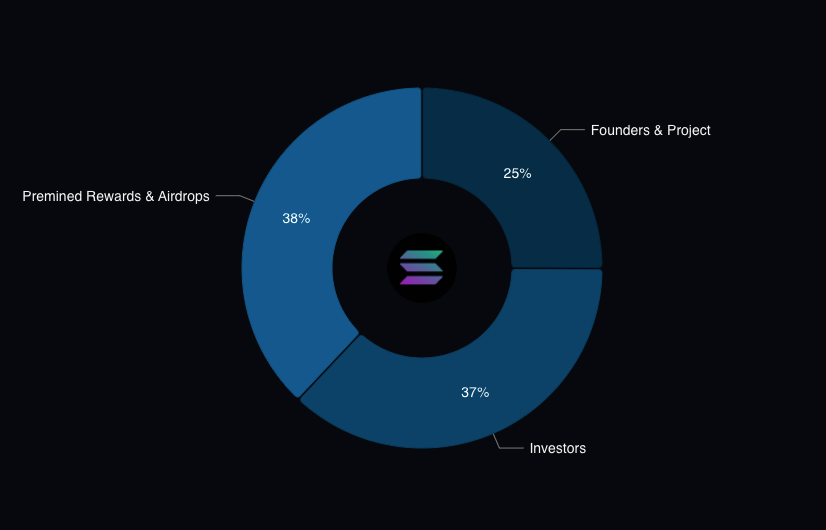
Staking: Solana vs Ethereum
Given that both Ethereum and Solana use a Proof of Stake (PoS) consensus mechanism this means both crypto assets SOL and Ether can be staked. Let's briefly review a few key stats regarding staking on Solana vs Ethereum.
Ethereum Staking
As part of the migration to Ethereum 2.0, Ether can be staked in order to validate transactions on the network and participate in consensus and in return, receive block rewards. As Ethereum.org writes:
Staking is the act of depositing 32 ETH to activate validator software. As a validator you’ll be responsible for storing data, processing transactions, and adding new blocks to the blockchain.
Solana Staking
In terms of staking Solana, users can choose to stake their SOL directly on the network or delegate to an active validator to secure the network. SOL stakers receive a reward from a portion of the network's current inflation rate as compensation. As Blockdaemon highlights:
The rewards per epoch is fixed and must be evenly divided among all staked nodes according to their relative stake weight (stake proportional) and participation.
In terms of the requirements to become a validator, there are no minimum amount of SOL required, although as the Solana docs highlight:
...in order to participate in consensus, a vote account is required which has a rent-exempt reserve of 0.02685864 SOL. Voting also requires sending a vote transaction for each block the validator agrees with, which can cost up to 1.1 SOL per day.
Scalability: Solana vs. Etheremum
As you probably know, one of the main complaints people have about Ethereum is the high gas fees. According to Etherscan's Gas Tracker, gas fees range from $22 - $68 per transaction, which of course is not practical for many day-to-day use cases. As network usage spikes during periods of high transaction activity, gas fees can often get to several hundreds of dollars.
While these bottlenecks and high gas fees do indicate the popularity of Ethereum's networks, the issue has opened the door to other layer 1's like Solana.
We all know that gas fees are an issue in Ethereum's current form, but let's briefly review how Ethereum 2.0 intends to solve this, as well as how Layer 2 solutions come into play.
Ethereum 2.0 and Scalability
One of the ways that Eth 2.0 intends to solve high gas fees is through sharding, which is the process of splitting one large blockchain into several smaller chains, or shards, to improve scalability. The goal of sharding is to increase the number of transactions the network can handle, thereby reducing congestion and gas fees.
Aside from scalability, Ethereum.org mentions several other benefits of sharding, including:
- Everyone can run a node: Sharding is a way to scale while still keeping things decentralized as the alternative is to scale by increasing the size of the existing database.
- More network participation: Eth2 will eventually be able to run on a personal laptop or phone thanks to sharding, resulting in more users being able to participate or run clients.
Shard chains are expected to ship in ~2023, depending on how quickly things progress after the Merge.
Solving Gas Fees with Layer 2 Solutions
Aside from the Eth 2.0 upgrade, there are a number of other solutions off the main Ethereum chain that allow developers to run DeFi apps much more cost efficiently. Known as layer 2 solutions, one of the most well-known scaling solutions is Polygon.
Polygon is a sidechain that has its own token ($MATIC) and is a proof-of-stake blockchian. Validators of the Polygon network confirm transactions of the side chain and then submit the current state of their network back to the Ethereum main chain.
Many of the leading dapps have already been built on Polygon with the ecosystem boasting 7000+ dapps already, a few of the most notable include Aave and SushiSwap.
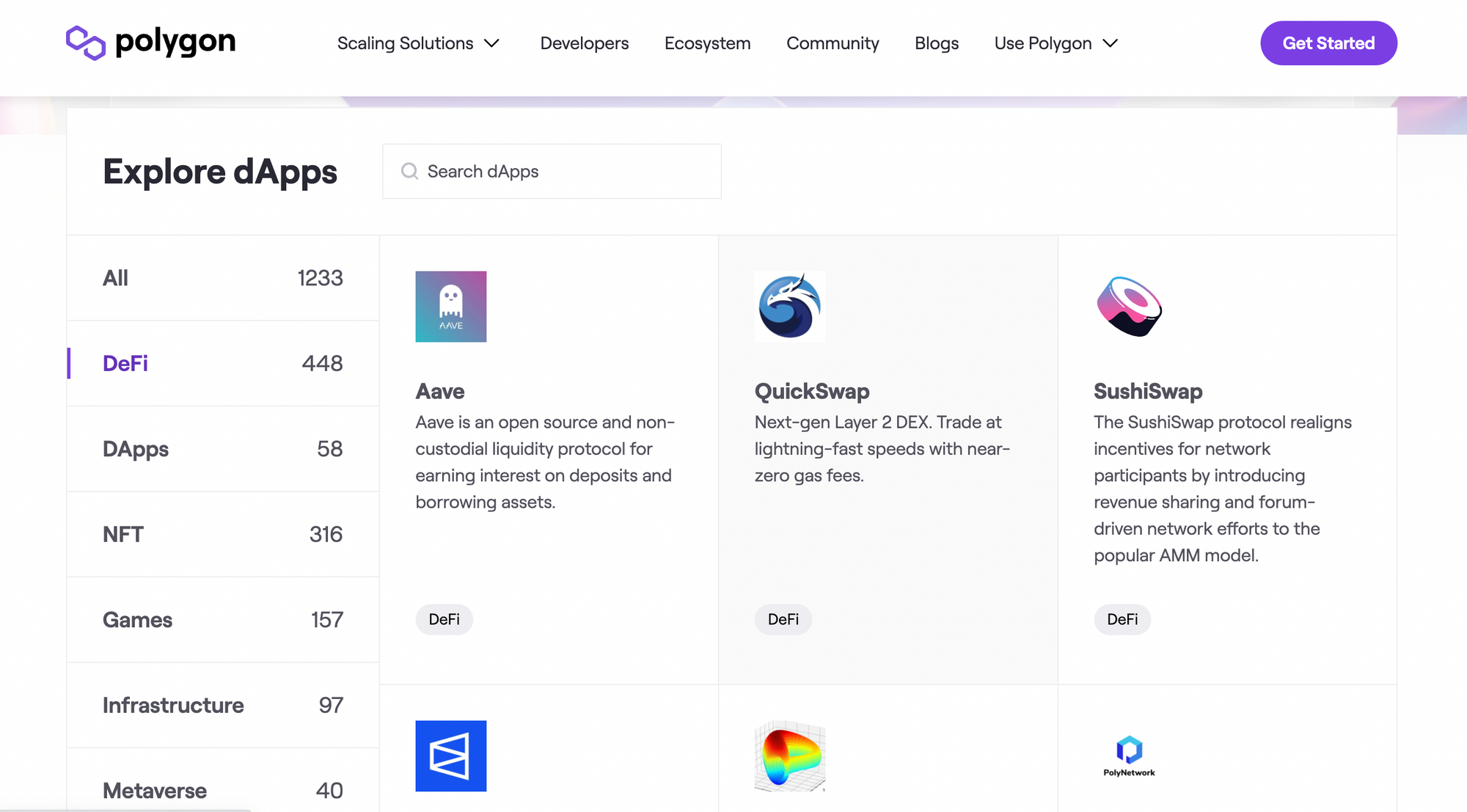
Solana: Scalability & Speed
One of the main reasons that Solana was created in the first place was to solve the well-known TPS scalability issues of both Bitcoin and Ethereum. Given that Ethereum blockchains struggle to scale beyond 15-30TPS and have high transaction fees, this presents a major roadblocks for adoption of cryptocurrencies in day-to-day transactions.
Below we can see that Solana is still the fastest layer 1 blockchain in terms of transactions per section and can currently handle ~65,000 TPS with near 0
TRANSACTIONS PER SECOND BETWEEN BLOCKCHAINS
— Solana Daily (@solana_daily) September 13, 2021
The chart below showed the Transaction per second between blockchains. So far, @solana is still the layer 1 which is able to handle the most transactions at once, 65,000 TPS, with the nearly 0 cost!#SolanaSummer #Solanaszn pic.twitter.com/kE7nrJ7Rzi
As mentioned, however, there are undoubtedly tradeoffs with Solana's increased scalability, most notably the significantly less decentralization in the network. It's also important to note that Solana has experienced several outages recently, resulting in more criticism.
The first outage occurred in December 2020 and lasted ~5 hours, although no funds were lost during the downtime. The second network outage occurred in September 2021 and last ~17 hours. The cause of the second outage was due to a denial of service attack and no funds were lost. The Solana team also provided an interesting insight into the resilience of blockchains in general:
One of the biggest benefits of blockchains is that, even in complete liveness failure for any reason, the validators are individually responsible for recovering the state and continuing the chain without relying on a trusted third party.
Solana experienced a third outage in January 2022 due to increased transaction load, which as you can see peaked at 400,000 TPS:
1/ Solana Mainnet Beta encountered a large increase in transaction load which peaked at 400,000 TPS. These transactions flooded the transaction processing queue, and lack of prioritization of network-critical messaging caused the network to start forking.
— Solana Status (@SolanaStatus) September 14, 2021
While many have expressed criticism and lost confidence in Solana, other notable figures in the crypto industry defended the blockchain. As FTX's Sam Bankman-Fried highlighted, despite the performance issues, Solana is still processing more transactions than all other major blockchains, combined:
4) As far as I can tell, during the week when it's had performance issues, and if you exclude all of the voting transactions from the TPS...
— SBF (@SBF_FTX) January 25, 2022
...it's still processed more transactions than all other major blockchains.
Combined.
Another key point that SBF made is that like with building any other innovative technology, here's always more work to do:
5) Yes, it hasn't processed as many as it could have. But it's still doing a ton.
— SBF (@SBF_FTX) January 25, 2022
Which is to say: there's more work to do. There's always more work to do.
And the most important thing is doing that work. Building.
Developers on Solana vs Ethereum
To conclude this Solana vs Ethereum comparison, let's look at a key aspect of any network adoption cycle: developer activity.
First off, according to a recent report from the crypto investment firm Electric Capital:
Web3 developers are at an all-time high and growing faster than ever. 18,000+ monthly active developers commit code in open source crypto and Web3 projects
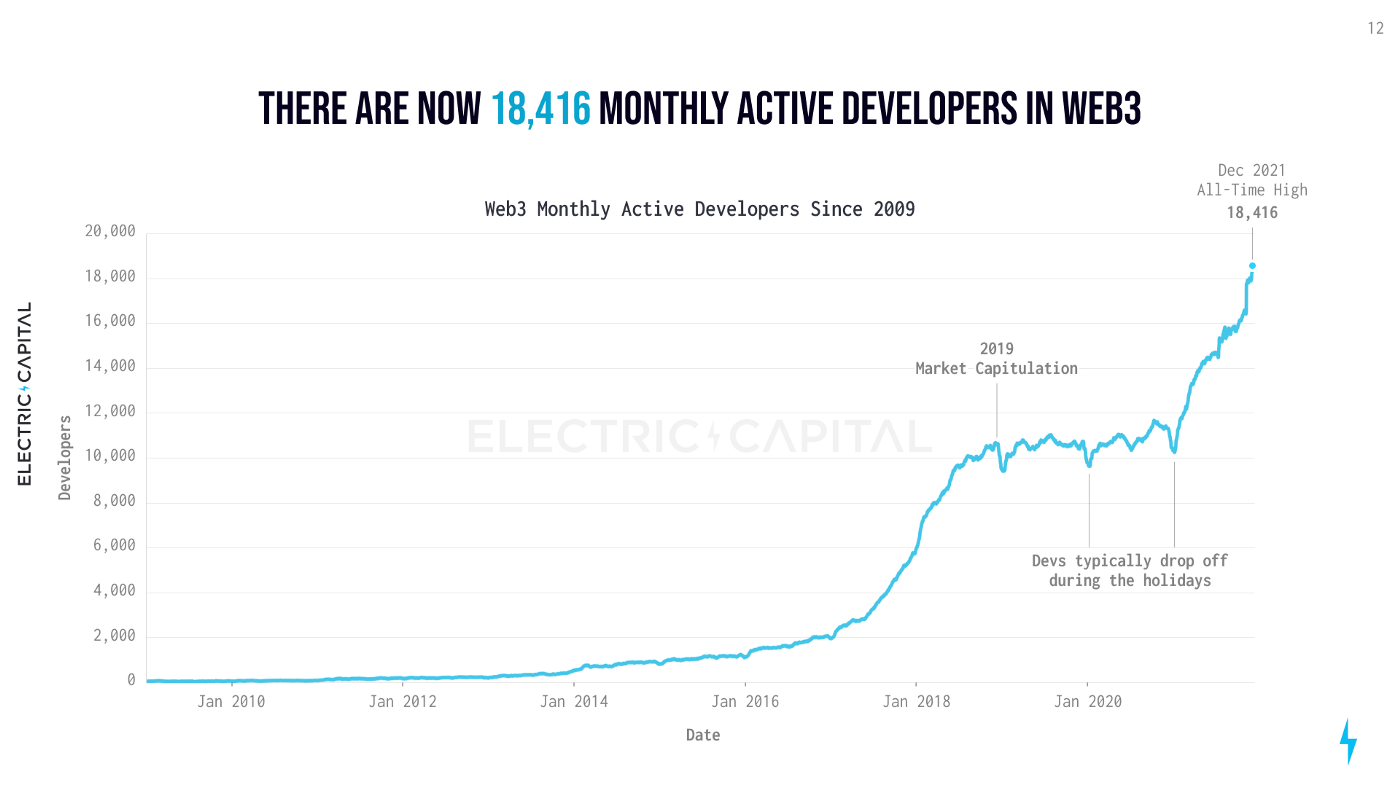
In the report, the authors highlight that the top 5 blockchain ecosystems in terms of developer activity are Ethereum, Polkadot, Cosmos, Solana, and Bitcoin.
The other key insights from this report is that developer activity on Polkdadot, Solana, Near, BSC, Avalanche, and Terra have seen faster initial ecosystem growth than Ethereum:

Although that is a nice headline, it makes sense that Ethereum's initial developer ecosystem grew slower as there were far fewer crypto participants at the time, let alone developers working in the space.
The report highlights that there are currently 4000+ monthly active open source developers working with Ethereum. On Solana, there are roughly 1000 open source developers working on various projects.
Summary: Solana vs. Ethereum
Both Ethereum and Solana have seen tremendous growth in developer activity, network usage, and of course token price over the last year.
In comparing Ethereum and Solana, and any other blockchain for that matter, it's important to keep in mind both have tradeoffs in terms of scalability, decentralization, and security. Regardless, it will will be interesting to watch how other layer 1's like Solana perform as Ethereum 2.0 rolls out in the coming months.
Disclaimer: The views and opinions expressed by the author are for informational purposes only and do not constitute financial, investment, or other advice. See out full Terms of Service for more information.






